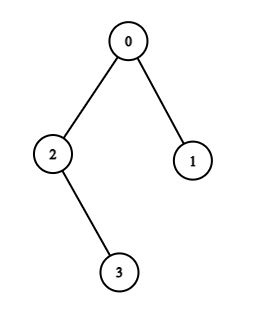题目链接
outputstandard output
You are given a tree with n nodes, numerated from 0 to n−1. For each k between 0 and n, inclusive, you have to count the number of unordered pairs (u,v), u≠v, such that the MEX of all the node labels in the shortest path from u to v (including end points) is k.
The MEX of a sequence of integers is the smallest non-negative integer that does not belong to the sequence.
Input
The first line contains a single integer t (1≤t≤104) — the number of test cases.
The first line of each test case contains a single integer n (2≤n≤2⋅105).
The next n−1 lines of each test case describe the tree that has to be constructed. These lines contain two integers u and v (0≤u,v≤n−1) denoting an edge between u and v (u≠v).
It is guaranteed that the given edges form a tree.
It is also guaranteed that the sum of n for all test cases does not exceed 2⋅105.
Output
For each test case, print n+1 integers: the number of paths in the tree, such that the MEX of all the node labels in that path is k for each k from 0 to n.
Example
inputCopy
2
4
0 1
0 2
2 3
2
1 0
outputCopy
1 2 1 1 1
0 0 1
Note
In example case 1,

For k=0, there is 1 path that is from 2 to 3 as MEX([2,3])=0.
For k=1, there are 2 paths that is from 0 to 2 as MEX([0,2])=1 and 0 to 3 as MEX([0,2,3])=1.
For k=2, there is 1 path that is from 0 to 1 as MEX([0,1])=2.
For k=3, there is 1 path that is from 1 to 2 as MEX([1,0,2])=3
For k=4, there is 1 path that is from 1 to 3 as MEX([1,0,2,3])=4.
In example case 2,

For k=0, there are no such paths.
For k=1, there are no such paths.
For k=2, there is 1 path that is from 0 to 1 as MEX([0,1])=2.
分析:
有一颗有n个点的树,顶点编号为 0 — n-1 。MEX是指除了u-v的路径上的点之外的编号最小值。题目求当MEX=0,1…n时的所有u-v的路径 ,即不包含0的所有路径,不包含1但包含0的所有路径,不包含2但包含0和1的所有路径…不包含n但包含0、1、2…n-1的所有路径。
令 ans[0] = n*(n-1)/2,即一棵树所有的路径数。
ans[1]表示包含0的所有路径数,则(ans[0]-ans[1])是MEX=0时的答案,即不包含0的所有路径。
abs[2]表示包含0和1的所有路径,则(ans[1]-ans[2])是MEX=1时的答案,即不包含1但包含0的所有路径。
…
#include<bits/stdc++.h>
#define ll long long
using namespace std;
const int N = 2e5+10;
const ll mod = 998244353;
int n;
int h[N],e[2*N],ne[2*N],idx,f[N],c[N];
ll size[N],ans[N];
void add(int a,int b)
{
e[idx]=b,ne[idx]=h[a],h[a]=idx++;
}
void dfs(int u)
{
size[u]=1;
for(int i=h[u];i!=-1;i=ne[i])
{
int v=e[i];
if(f[u]==v) continue;
f[v]=u;
dfs(v);
size[u]+=size[v];
}
}
int main()
{
int T;
scanf("%d",&T);
while(T--)
{
memset(h,-1,sizeof(h));
idx=0;
scanf("%d",&n);
int a,b;
for(int i=1;i<n;i++)
{
scanf("%d%d",&a,&b);
add(a,b),add(b,a);//连边
}
dfs(0);//以 0为根,求得子树的顶点数 size
ans[0]=1LL*n*(n-1)/2;//所有路径
ll sum=1;
for(int i=h[0];i!=-1;i=ne[i])
{
int v=e[i];
ans[1]+=sum*size[v];//ans[1]是包含0的所有路径
sum+=size[v];
}
a=0,b=0,c[0]=1;//当前a-b表示一条包含0的路径 ,c[i]=1表示i实在a-b这条路径上
int p,x;
for(int i=1;i<n;i++)
{
if(!c[i])//如果当前i点不在a-b这条路径
{
x=p=i;
while(!c[x]) c[x]=1,p=x,x=f[x];//从i点往上找,找到与a-b这条路径连接的点x
if(x==a)
{
size[a]-=size[p];
a=i;
}
else if(x==b)
{
size[b]-=size[p];
b=i;
}
else break;//表明当前已经无法找到一条包含0、1、2...i的路径
}
ans[i+1]=size[a]*size[b];//包含0、1、2...i的所有路径
}
for(int i=0;i<=n;i++)
{
printf("%lld ",ans[i]-ans[i+1]);
}
printf("\n");
for(int i=0;i<=n;i++)
{
size[i]=ans[i]=f[i]=c[i]=0;
}
}
return 0;
}






















 369
369











 被折叠的 条评论
为什么被折叠?
被折叠的 条评论
为什么被折叠?








